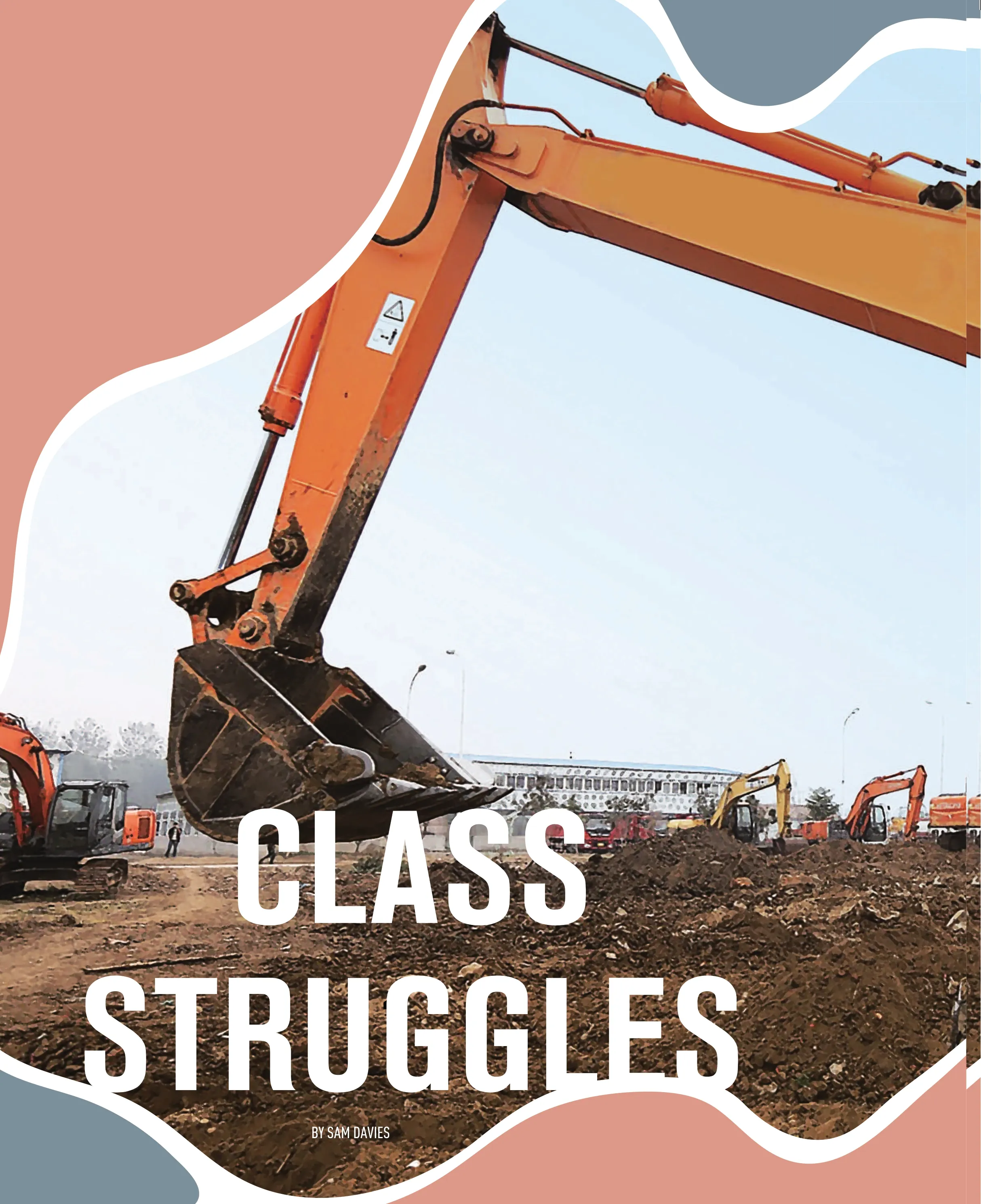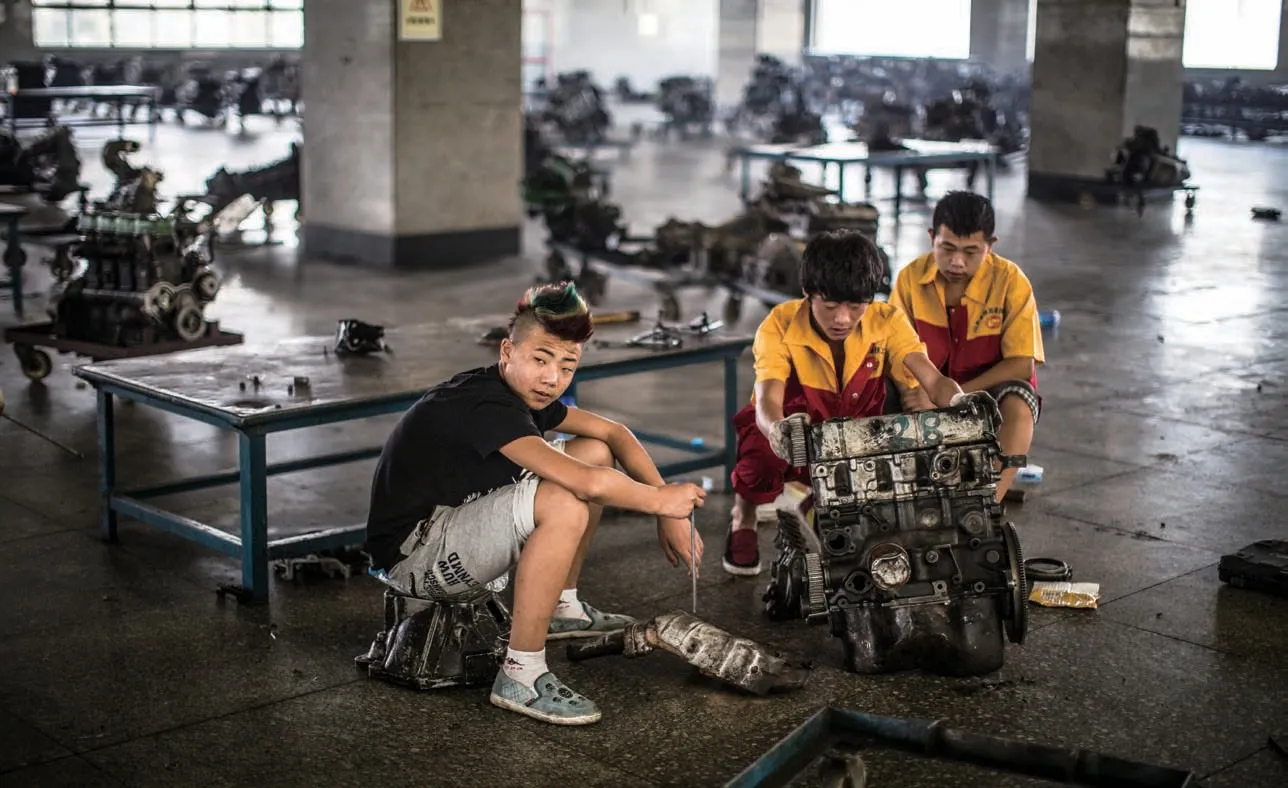CLASS STRUGGLES
BY SAM DAVIES


On paper, Xiaoxin’s schedule looks like that of any other overburdened teenager in China’s education system:crammed full of English,math, Chinese, and political theory courses from 6:40 a.m. to 8 p.m., with additional courses on railway signaling,service standards, and x-ray machine usage for her major, railway hospitality.In reality, though, most of her schoolmates barely get a chance to pick up their x-ray wands in class, so busy are they chitchatting, reading novels, getting into shouting matches with teachers, and catching up on sleep after a night of video-gaming in the dorms—that is, the 50 percent of the class that hasn’t already dropped out of school to find work, or simply stopped showing up to lectures.
And after class, when millions of Xiaoxin’s fellow 18-year-olds around China are hunkering down to cram for the national college entrance exams (gaokao), her descriptions of dorm life consist of tales of burst pipes, hairdryers catching fire, broken washing machines, and classmates brawling over trivial matters like who can borrow a rechargeable card for showering. “Every day, I feel like I’m trying to survive in the wilderness,” she tells TWOC.
Xiaoxin, who asked not to use her real name in this story, is one of the 16.6 million teenagers enrolled in over 10,000 vocational secondary schools around China, making up around 40 percent of all students at high-school level education in the country.
Officially known as “Secondary Professional Schools (中等專業學校),” orzhongzhuan(中專) for short,these institutions teach technical or occupational skills for employment rather than prepare students for university, and have lately come under the public’s scrutiny for underfunding, out-of-date equipment and teaching materials, student apathy and misbehavior, and poor teaching standards.
In October of this year, a viral WeChat article by the account Zhengmian Lianjie referred to China’s vocational students as the“vanished 40 percent,” whose voices are rarely heard in mainstream media.The same month, Chu Chaohui, a researcher at the National Institute of Education Sciences (affiliated with the Ministry of Education), called China’s vocational education system“embarrassing” and “backward” in an interview with Sanlian Lifeweek magazine.
In June, the shocking suicide of a 17-year-old vocational high school student in Shenzhen, who’d been forced to take an internship working on an assembly line and moving crates at an electronics factory, despite majoring in computer studies, brought the low-quality teaching and abusive learning environment of many vocational schools to public attention.
This is despite recent government attempts to reform vocational schooling and vows to “substantially increase the attractiveness of vocational education and its acceptance by society,” a promise made in a three-year vocational education action plan by the Ministry of Education (MOE) and eight other government agencies in 2020. This October, the MOE also announced plans to “reduce the barrier forzhongzhuanstudents to enter higher education” and to create a “vocational educationgaokao” for admissions to university in the future.
Xiaoxin is in her third and final year of study at a private vocational high school, which she declines to name, in Nanjing, the capital of the east-central Jiangsu province. She enrolled after twice failing the national high school entrance examination, orzhongkao(中考). Though her family pays 13,000 RMB per year in tuition and dorm fees, several times higher than the cost of attending a public vocational or high school in Nanjing, Xiaoxin complains of “shoddy” equipment(“there aren’t enough x-ray wands to go around”) and indifferent teaching(“the teacher who taught us math in our first year taught us politics in our second year”).

Many migrant children who cannot take the zhongkao in their adopted cities end up attending vocational high schools
While thegaokaodetermines whether Chinese high schoolers can go to university, and to which one, nearly half of all Chinese teens never get to sit that exam. The more important exam for them is arguably thezhongkao, which most teens take after finishing nine years of compulsory education, when they are around 16 years old. Those who qualify after taking thezhongkaocan attend regular high schools, orgaozhong(高中), which prepare students for thegaokaoand provide a clear pathway to university and, in theory, white collar employment.
But the MOE sets an annual national quota of around 50 percent of all examinees who can pass thezhongkaoand matriculate to high school. Local governments then set the specific scores for passing, depending on the number of high school spots available that year. Pass rates are generally higher in affluent urban areas, while in poorer rural locations, a higher majority may fail to make the cut,meaning they cannot go to high school and are unlikely to go to university.Teens who do not qualify for high school can choose to leave school and find work, or they can attend one of three types of vocational schools managed under different government ministries: a secondary professional school, an occupational high school orzhiye gaozhong(職業高中), or technical school orjishu xuexiao(技術學校), thoughzhongzhuanis often used as a catch-all term for all three.Theoretically, these schools provide students with technical or occupational training for specific jobs within three years: such as a chef, train attendant,elderly-care giver, or nurse.
But in school, students often complain they aren’t taught any useful job skills. “What I learned at vocational school was pretty basic,” says Bai Gewei, a graduate of Shanghai Shipyard Technical School, who remembers learning to use Microsoft Word, PowerPoint, and PhotoShop as part of her e-commerce major.
Bai, who grew up in a singleparent family from the impoverished Liangshan region of the west-central Sichuan province, funded her vocational program with help from an NGO. After graduating in 2020, Bai joined the Shanghai company where she’d completed an internship as part of her studies, but soon left due to the low salary.
When she found her next job, in sales,she discovered that her vocational school diploma not only did not give her relevant skills, it actually decreased her marketability. “Because my education level was [considered] ‘low,’
But after the government slashed the number of state-owned enterprises and effectively ended the work-unit system, leading to the disappearance of these “iron rice bowl” jobs and the benefits they offered, the value of vocational skills quickly evaporated under the market system. At the same time, a massive expansion of higher education began in 1999, with new enrollments in universities rising from 1.1 million in 1998 to 4.47 million by 2004. Between 2009 and 2020, China listed nearly 200 new institutions offering undergraduate courses.the starting salary was 2,500 RMB,”she says—in comparison, the average salary for recent university graduates in Shanghai is 7,200 RMB, according to job hunting website Zhiyouji.

In theory, vocational schools are meant to equip students in skilled work such as cooking, nursing, or machine-operation
A technical education did not always carry a stigma. Before China undertook sweeping reforms of the state-owned sector in the 1990s, vocational schools were prestigious, difficult to enter,and led to state-guaranteed lifetime employment with a stable salary and access to some of the country’s best health care, education, and housing for their families in factory compounds.
Now, with so many university graduates for employers to choose from—over 9 million undergraduate diplomas were issued in 2021—the value of a vocational degree is miniscule in the job market.
According to Ouyang Wenwei,a teacher at a vocational school in Shenzhen, many of his students would go to work in the Shenzhen subway system after graduation until around 2002. Since then, the minimum job requirements have increased to graduates of postsecondary vocational colleges or even higher, he told Sanlian Lifeweek in October this year.
Now, even blue-collar jobs can require university education. At one cigarette factory in the central Henan province,41 of 135 new employees had postgraduate qualifications, according to a report by Time Weekly magazine in July this year.
Since the government began expanding vocational education around four decades ago, the number of students enrolled has rocketed from 19 percent of all high-school-age students in 1980 to 45.3 percent in 2001,according to the MOE. But funding has always lagged behind: In 2017, regular high schools received over double the funding of vocational high schools,according to MOE figures.
Some schools, particularly private ones, have struggled to fill places on courses and been so strapped for tuition money that they have resorted to fraud.In 2019, police detained the heads of two vocational schools in Nanjing that had entered students into non-existent nursing programs and falsely advertised partnerships with businesses.
Luo Wen, an English teacher at Wuhan Number Two Central Vocational School, believes the lack of funding leads to significant disparities in different schools. “Teaching materials in regular high schools generally get updated every three years, but here it is around every 10 years, so the school can’t keep up [with the skills employers want],” she tells TWOC.
For schools that purport to teach students practical job skills, that is a big problem: “By definition we should update our curriculum faster [than regular high schools],” Luo says.
Wang Qunhong from Ji’an, in the southeastern Jiangxi province, who graduated from a technical hygiene school in 2009, remembers having just “one or two practical classes” per week during the first two years of her three-year program in nursing. “We didn’t ever get to practice on real people,” she tells TWOC. It was only in her third year, when she and her classmates interned at a hospital, that they were able to do injections and infusions on patients.

Practical work experience is meant to be a big part of the vocational curriculum
Like Xiaoxin, Wang says she and her classmates didn’t pay much attention in classes on anatomy, or academic lessons on English, math, and Chinese,preferring to read novels while teachers droned on indifferently.
As a teacher, Luo says most students at her school detest learning English,believing it will have no use in their lives after graduation. She believes apathy is the major problem amongzhongzhuanstudents: “They can restrain their bad behavior, but you can’t make them participate actively in their learning.”
Despite government figures showing the employment rate for vocational high school graduates at above 95 percent every year since 2007, these jobs are often precarious. Luo says graduates from her school usually look for temporary employment and change jobs often. These are usually basic service jobs like sales in a mall,or waiting tables.
In a vicious cycle, a lack of funding and a poor study environment contributes to this failure to gain useful skills, which further devalues the perception of a vocational education in the eyes of employers and Chinese society, and leads to discouraged parents and unmotivated students. Vocational students also share anecdotes of bullying and violence in their schools: Xiaoxin, after reporting a gang of girls for beating up another girl in her dorm, said her teacher took no action, and it made her no longer trust the school authorities.
Stories like these have given vocational schools and their students a woeful reputation. The typical route intozhongzhuan—that is, by missing the pass mark for thezhongkao—means that students enter the vocational system already defined by failure. “You will often hear people saying that the students who go to vocational high school are those who are not good at their studies, or have bad behavior,” says Wang Zijin, a researcher and project manager at Guangzhou-based NGO Clover Youth, which runs programs to help vocational students improve their self-esteem, as well as teaching workshops forzhongzhuanteachers.
“In people’s imagination, poor grades correspond to other aspects of the person, such as poor ability and poor self-discipline, or even poor moral character,” says Wang Zijin.
Failing thezhongkaohas taken a toll on Xiaoxin’s self-confidence. “I feel I’m useless,” she says. “I fell short of expectations…everyone is changing for the better, but I’m still making no headway, or even falling behind.”
She feels she exists in a world apart from her primary school classmates who are now in high school, and is afraid to contact them. “I don’t want to disturb their studies,” she says. “They probably don’t have any time to play on their phone anyway.”
Luo feels the family background of typical vocational students may also impact their self-esteem: “These students may have a variety of nontraditional family arrangements,like being from single-parent families, or being brought up by their grandparents…they may distrust people.” According to the MOE, 70 percent of vocational students come from the countryside.
A 2020 study by researchers from Foshan University and the University of Macau found that vocational students are more likely to show“delinquency” and lower social control than students in regular high schools.Other studies also suggest rates of depression, anxiety, and feelings of inferiority in their study, appearance,and social life are higher for vocational school students.
Even the teachers suffer discrimination, according to Luo:“When we go to teacher training, or go to open lectures…you can feel that regular high school teachers look down on vocational school teachers.” Many of Luo’s colleagues have moved to high schools for better teaching facilities,more prestige, and better-behaved students—even better dormitories.
Improving the quality of vocational education and allowing it to produce the skilled workers China’s modernizing economy needs requires“more overall investment, investment in teachers…and giving schools more resources to cooperate with better companies, so the students can find good employment,” says Wang Zijin.
The government is attempting to bridge the gap between vocational and academic education. In 2019, premier Li Keqiang announced 100 billion RMB for “vocational upskilling,” and the MOE has promised to reform admission tests to get into vocational schools to include at least 50 percent skills-based practical components.

The government aims to recruit more teachers with industry experience and connections to improve technical instruction
NGOs are also stepping in. BN Vocational School (BNVS) is a free,non-profit vocational high school which operates 10 branches in multiple regions across China. Bo Wen, principal of a BNVS school in Zhengzhou, the capital of Henan province, believes vocational education is vital to improving the employment prospects of Chinese youths, and to alleviating the financial pressure of education on their families. “Not every child is suited to regular high school or academia…most students who take vocational education are not suited to the traditional exam-oriented model,”he tells TWOC.
But Bo’s school only takes 20 students per major, and about 40 new students a year. Running the school costs 2 million RMB annually, all funded by donations, and it’s difficult to see how such a model could be scaled nationwide without state support.Bai, unsatisfied with her career prospects with azhongzhuandiploma,has now returned to her hometown in Sichuan. “I saved a bit of money for tuition and will [study to] take thegaokao,” she says.
Xiaoxin, now preparing to take her exit exams and get into vocational college, says she now regrets not taking her studies seriously and failing thezhongkao. Similarly, Wang Qunhong, who quit her job as a nurse in Beijing (making 3,000 to 4,000 RMB a month) within a few years of graduation, and now makes 20,000 RMB per month selling insurance, says she feels “bitterness”for not having studied hard enough to qualify for high school.
She has also moved back to her hometown specifically so that her sons, both in elementary school,can one day have a better chance of getting into a good high school using their local household registration.“I have had to work very hard to get the high salary I have now.If I didn’t work hard, society wouldn’t care about someone [of my background],” she says. With the right diploma, she hopes, her children will never have to face such a choice.

